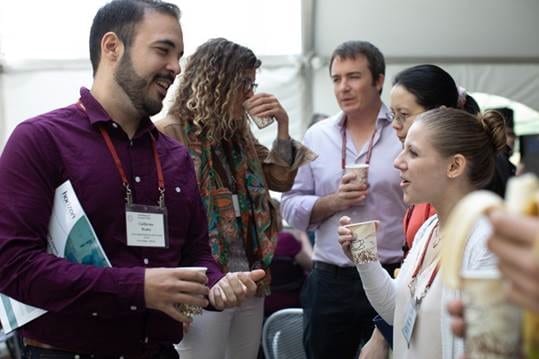Posted By: Emily C. Glassberg, PhD Candidate, ASHG Communications Committee
A few weeks ago, I attended the 31st annual Biology of Genomes (BoG) meeting at Cold Spring Harbor. In addition to highlighting the amazing research that comprises the current state of genomics, this meeting highlighted the storied past and bright future of the field. The enthusiastic participation of attendees, both at the meeting and on Twitter, shows incredible energy and momentum as we try to understand the genome’s role in biology, evolution, and disease.

Genomics Present
The seven scientific sessions covered functional genomics, medical genomics, computational genomics, and evolutionary genomics, as well as genome engineering. Seeing this varied body of work at a single meeting clearly demonstrates that theory, experiment, high-throughput screening, and countless forms of new technology and data analysis all play central roles in shaping our current understanding of the human genome.
And, while the human genome was the primary subject of study, non-human genomes got coverage as well. Highlighted research included the genomes of near relatives, like Neanderthals; to those of best friends, like dogs; to those of model organisms, like yeast. Crowd favorites included Jaemin Kim’s and Elaine Ostrander’s talks using dogs as a system to learn about the genetic basis of complex traits (for the science as well as the adorable pictures).
The scientific programming also included two keynote speakers, Wendy Bickmore and David Page. Bickmore discussed her group’s work on how 3D chromatin structure relates to the mechanism by which enhancers – particularly long-range enhancers – interact with promoters to regulate gene expression.
Bickmore’s emphasis on the need to assay enhancer function in vivo was echoed elsewhere at the meeting. In particular, Emma Farley spoke about high-throughput measurements of enhancer function in the model chordate Ciona. In combination, these talks sparked a conversation about whether current computational models are looking in the wrong places when it comes to predicting enhancer activity and specificity.
Page presented his group’s work on the evolution of sex chromosomes with an eye to understanding sex differences in health and disease. Page’s question of whether and how males and females “read their genomes differently” connected to broader questions that recurred throughout this year’s meeting – how do we understand the genome dynamically? When and how does the same genome lead to different outcomes?
The ways in which the genome and its downstream effects change over time and space is a big open question, and this year’s BoG showcased many approaches to tackling it:
- Ben Strober and Jonathan Griffiths both used time-course gene expression data to track how gene regulation changes throughout cellular differentiation and development.
- Jake Yeung shared an example of dynamic chromatin interactions and rhythmic promoter-enhancer contacts that are connected to circadian rhythm.
- Christina Leslie presented work on how the chromatin state of tumor specific T-cells changes during cancer progression and how that influences disease treatability.
And that’s just a sample of the exciting work in this space! While we don’t yet have clear answers to these questions, the research discussed at BoG reveals a landscape that is complex, nuanced, and fascinating. What a great time to be in genomics!
Genomics Past
In addition to discussions spanning the range of the current field of genomics, BoG included a brief talk in memoriam of molecular and developmental geneticist John Sulston, who passed away on March 6, 2018. Dr. Sulston was well known for his seminal work in the now-model organism C. elegans, as well as his role in the Human Genome Project. Eric Lander also toasted Jim Watson for his role in the Human Genome Project, and to celebrate his 90th birthday. Lander and other BoG organizers later apologized for the toast, as it was seen by many in the community as minimizing Watson’s history of racist and sexist commentary.
Genomics Future
And, finally, no meeting would be complete without a vision for the future of the field.
A panel on the Ethical, Legal, and Social Implications of genomics research included four perspectives on the promises and pitfalls of germline genome editing. While there is considerable excitement around using CRISPR to cure genetic disease, many issues remain regarding proof of safety as well as ensuring equal access to the technology. Following a lively discussion during the question-and-answer, the consensus seemed to be that germline genome editing is a distant future. In the meantime, we can focus on the application of currently available options, like genetic screening and assisted reproductive technologies.
The National Human Genome Research Institute (NHGRI) also engaged researchers in its current strategic planning initiative, which began in February 2018 and will be completed in 2020. NHGRI is collecting input on priority areas to help the institute live up to its mantra, The Forefront of Genomics.
Of course, the scientific discourse at Biology of Genomes isn’t limited to the talks. The three lively poster sessions were great opportunities to exchange ideas. And many spirited discussions took place during the coffee breaks, over the traditional Cold Spring Harbor banquet, and down at Blackford bar. All told, there’s a lot to look forward in genomics!
Emily C. Glassberg is a PhD Candidate in the Department of Biology at Stanford University. She serves on ASHG’s Communications Committee and has been an ASHG member since 2014.
